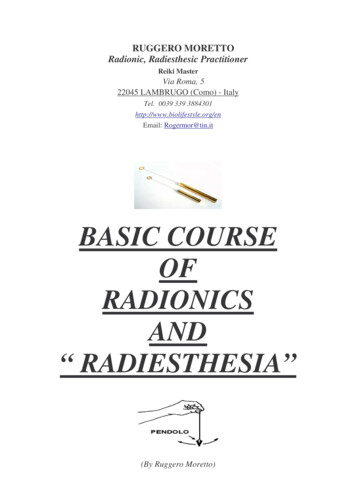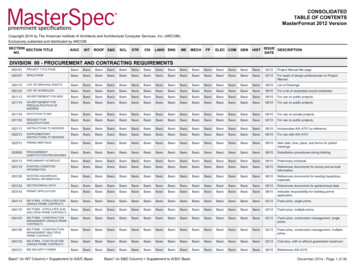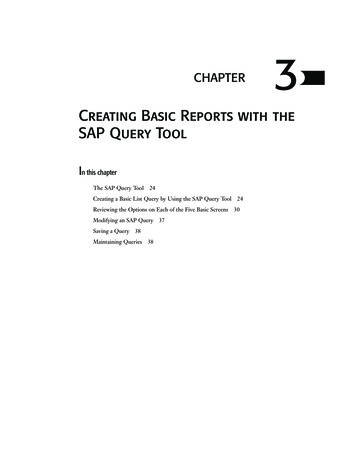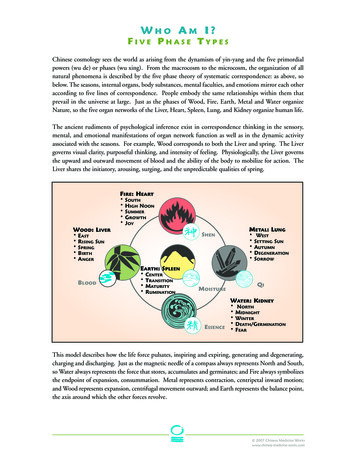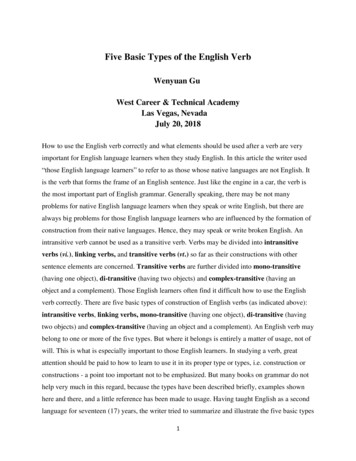
Transcription
Five Basic Types of the English VerbWenyuan GuWest Career & Technical AcademyLas Vegas, NevadaJuly 20, 2018How to use the English verb correctly and what elements should be used after a verb are veryimportant for English language learners when they study English. In this article the writer used“those English language learners” to refer to as those whose native languages are not English. Itis the verb that forms the frame of an English sentence. Just like the engine in a car, the verb isthe most important part of English grammar. Generally speaking, there may be not manyproblems for native English language learners when they speak or write English, but there arealways big problems for those English language learners who are influenced by the formation ofconstruction from their native languages. Hence, they may speak or write broken English. Anintransitive verb cannot be used as a transitive verb. Verbs may be divided into intransitiveverbs (vi.), linking verbs, and transitive verbs (vt.) so far as their constructions with othersentence elements are concerned. Transitive verbs are further divided into mono-transitive(having one object), di-transitive (having two objects) and complex-transitive (having anobject and a complement). Those English learners often find it difficult how to use the Englishverb correctly. There are five basic types of construction of English verbs (as indicated above):intransitive verbs, linking verbs, mono-transitive (having one object), di-transitive (havingtwo objects) and complex-transitive (having an object and a complement). An English verb maybelong to one or more of the five types. But where it belongs is entirely a matter of usage, not ofwill. This is what is especially important to those English learners. In studying a verb, greatattention should be paid to how to learn to use it in its proper type or types, i.e. construction orconstructions - a point too important not to be emphasized. But many books on grammar do nothelp very much in this regard, because the types have been described briefly, examples shownhere and there, and a little reference has been made to usage. Having taught English as a secondlanguage for seventeen (17) years, the writer tried to summarize and illustrate the five basic types1
of the English verb, on the basis of his teaching experience and extensive review of variousliteratures from different English grammar books, reference books, and the consultation ofEnglish dictionaries, in order for those English learners to further understand how to use the verbcorrectly.The present illustration of various sentences is intended to present the usage of the five basictypes of the English verb in a way that is to be logical, instructive, and comprehensible. It will beintroduced in the order given above.I. The Intransitive TypeThe intransitive verb (vi.) is one which makes a complete sense by itself and does not require anyword or words to be added to it for this purpose. That is, the intransitive verb does not take anobject. The sentence structure should be subject-verb (SV) form, as in1. Rivers flow. (Rivers is the subject and flow is an intransitive verb. It is SV.)2. Winds blow. (Winds is the subject and blow is an intransitive verb. It is SV. )3. Birds fly. (Birds is the subject and fly is an intransitive verb. It is SV. )4. All animals sleep. (All animals is the subject and sleep is an intransitive verb. It is SV.)5. Men walk. (Men is the subject and walk is an intransitive verb. It is SV.)6. Fish swim. (Fish, a collective noun, is the subject and swim is an intransitive verb. It is SV.)7. Storms arise. (Storms is the subject and arise is an intransitive verb. It is SV. )8. All animals die. (All animals is the subject and die is an intransitive verb. It is SV.)9. The sun rises. (The sun is the subject and rises is an intransitive verb. It is SV.)10. The ship sank. (The ship is the subject and sank is an intransitive verb. It is SV.)All the verbs given in the sentences above can stand by themselves, that is, no other elements arefollowed, so they are the intransitive type. An intransitive verb (vi.) is not followed by an objectas seen above, but an intransitive verb can be followed, most of the time, by a prepositionalphrase [14, 15] or an adverbial [11, 12, 13, 14]. It falls into the subject-verb-adverbial (SVA)pattern besides SV, as in11. He walks every morning. (He is the subject, walks is the intransitive verb, and every morningis the adverbial of time. It is SVA.)2
12. The old man sleeps downstairs every day. (The old man is the subject, sleeps is theintransitive verb, downstairs is the adverbial of place, and every day is the adverbial oftime. It is SVAA.)13. He works hard. (He is the subject, works is an intransitive verb, and hard is an adverb, whichis used as the adverbial of manner. It is SVA.)14. The Titanic sank after hitting an iceberg. (The Titanic is the subject, sank is the intransitiveverb, and after hitting an iceberg is the prepositional phrase, which is used as the adverbial oftime. It is SVA.)15. These planes can fly at incredibly high speeds. (These planes is the subject, fly is aintransitive verb, and at incredibly high speeds is the prepositional phrase, which is used asthe adverbial of manner. It is SVA.)16. These shirts wash well. (SVA)17. The meat cuts easily. (SVA)18. Oranges are selling cheaply today. (SVAA)19. The door doesn’t open in wet weather. (SVA)Note that many verbs can be used in a passive sense in such sentences [from 16 to 19] as shownabove, for example. Palmer (1978) called these sentences “pseudo-passive”. Of course, there arehundreds of intransitive verbs, in fact, too numerous to enumerate. And as has been pointed out,a verb may fall into one or more types. For instance, the verb blow, fly, or even die may be usedas a mono-transitive in subject-verb-object (SVO) pattern or subject-verb-object-adverbialpattern (SVOA). They are transitive verbs (vt.), as in20. He blew the candle out. (SVOA)21. We fly a kite once a week. (SVOA)22. Some people die an early death. (SVO)In fact, many English verbs have a transitive and an intransitive use. Each construction has to belearned by heart. Death in Sentence 22 above is called “cognate object.” (Also see CognateObjects in SVO construction below in A. The Mono-transitive Type.)II. The Linking Verb TypeA linking verb is a verb which is followed by a predicative to introduce what the subject is or islike. It falls into the subject verb complement (SVC) sentence structure. Some grammarians3
called it subject complement. The verb be is a typical linking verb which is usually followed bya noun [1, 23] or noun phrases [2, 9], pronouns [4, 5], a gerund or gerundial phrase [3], aninfinitive or infinitive phrase [10, 11], participles (present participle or past participle used asadjectives) [6, 7. 8], adjectives [20, 22], a numeral [12,13], an adverb (usually denoting “place”)[15, 16, 17], prepositional phrases [14, 25, 26, 27, 28, 29, 30, 31, 32, etc.], and noun clauses [18,19]. Its SVC structure may resemble a mono-transitive (SVO) in form, when the predicative is anoun [1, 47]. The following are some of the examples of SVC:1. He is a teacher. (Is is a linking verb followed by a noun, a teacher. It is SVC.)2. It was a clever excuse but it didn’t really ring true. (A clever excuse is a noun phrase used ascomplement. It is SVC.)3. My hobby is collecting stamps.(Collecting stamps is a gerundial phrase used as complement. It is SVC.)4. It was they that did it. (They is a pronoun used as complement. This is an emphaticalsentence - also called a cleft sentence. It is SVC.)5. That’s something we should keep in mind. (Something is a pronoun. It is SVC.)6. He is amazing. (Amazing is a present participle used as adjective. It is SVC.)7. Time is pressing. (Pressing is a present participle used as adjective. It is SVC.)8. They are married. (Married is a past participle used as adjective. It is SVC.)9. She was all smiles when I came in.Note that all used with countable nouns after the verb, be, can also be the subject complement asseen [9] above. More examples: They were all eyes when I opened the present. Tell me yourplan, and I am all ears.10. To see is to believe. (To believe is the infinitive with to used as complement. To see is usedas subject. It is SVC.)11. My job is to help you today.(To help you is the infinitive phrase used as complement. It is SVC.)12. It is three. (Three is a numeral used as complement. It is SVC.)13. She was the first to arrive and the last to leave. (The first and the last are numerals. It isSVC.)14. They are in the cafeteria. (The prepositional phrase, in the cafeteria, is used ascomplement. It is SVC.)4
15. He is here (there, in, out, away, off, downstairs, etc., these adverbs denote “place.”)16.The storm is over now. (Over is an adverb.)17.The price of iphone 6 is down. (Down is an adverb.)18. The reason is that we are behind others in industry.(That we are behind others in industry is a noun clause used as complement/predicative. It isSVC.)19. That is where he died. (Where he died is a noun clause used as complement/predicative.It is SVC.)20. She is healthy/interesting. (Healthy and interesting are adjectives.)21.The girl was born blind and deaf. (Blind and deaf are used as subject complement.It is SVC.)22. He was very intelligent. (In informal speech, when the speaker wishes to emphasize thecomplement, the complement can be moved before the subject, as in “Very intelligent hewas.” Also see sentences below from 35, 36, 37, 38, 39, 40, 41, and 42.23. They are doctors from Las Vegas. (Doctors is a noun. It is SVC.)24. He has a teacher. (a mono-transitive. It is SVO.)We can also say, “She is happy.” “Happy” is an adjective, and an adjective is typical of thepredicative. So we call “is” a linking verb. But we cannot say, “She has happy”, which makes nosense grammatically. As stated above, most of the time, the linking verb, be, is usually followedby an adjective. When a prepositional phrase is used as predicative/complement, it denotesquality, place, company, resemblance, time, cause, purpose, opposition or favor, as in25. This is of importance. (The prepositional phrase, of importance important, denotingquality)26. He is in the room. (place)27. She is not with us now. (company)28. He is like his father. (resemblance)29. Supper is at six. (time)30. This book is for reading at leisure. (purpose)(For reading at leisure is a prepositional phrase. Reading is a gerund used after thepreposition, for.)31. I am for your proposal. (favor)5
32. She was against your proposal. (opposition)33. His failure is due to laziness. (reason or cause)34. The tool is of great use. (quality)Note that sometimes the subject complement (the predictive) is transposed before the subject inorder to give emphasis to the complement in exclamatory sentences introduced by how or whatand in the adverbial clauses of concession or reason, as in35. I wish her success, and successful, I knew, he would be. (It is still SVC.)36. How nice he is! (Exclamatory sentence; it is still SVC.)37. What a pretty girl she is! (Exclamatory sentence; it is still SVC.)38. Strong man that he is, he has been severely put to test during the past few weeks.(Adverbial clause of reason Because/As he is a strong man, he has been . )Note that there is no indefinite article a used before strong man. Therefore, it’s incorrect to say,“A strong man that he is, he has been severely put to test .”)39. Child as he is, he knows math better than I. (Adverbial clause of concession - Although he isa child, he knows math better than I.)Note that there is no indefinite article a used before child when it is placed before the subject insuch a case. It is incorrect to say, “A child as he is, he knows .”)40. Hot as the day was, they still worked in the garden. (Adverbial clause of concession)41. Situated as it was at the foot of the mountain, the house was very quiet. (Adverbial clause ofreason.)42. Rich as he is, (yes) I don’t envy him. (Adverbial clause of concession) I don’t envy him, even though he is rich.Besides be, there are a few linking verbs in English (also usually followed by adjectives). Theyare: appear, come, become, come, continue, fall, feel, get, go, grow, keep, look, prove, remain,rest, ring, run, seem, smell, sound, stand, stay, taste, turn, etc. The following are illustrations ofsome of the above linking verbs that are followed by an adjective [43, 44, 45, 46, etc.], a noun[47], as in43. They looked angry (happy, upset, pleased, etc.).44. Everything will come right in the end.45. They look married. (Married is a past participle used as adjective.)6
46. She became famous (interested, etc.).47.Mr. Marlowe became a lawyer, but Mr. Roser remained a judge.(It’s SVC. A lawyer and a judge are nouns used as complement to their subjects.)48. The little girl got hungry (angry, happy, excited, strong, etc.).49. She was growing old (thin and pale, agitated, upset, etc.).50. He appeared quite well (strong, healthy, etc.).51. My hair is turning grey (white, etc.).52. The pieces of cloth feels coarse (smooth, soft, etc. )We also say, “She feels ill.” “She doesn’t feel well.”53. The weather is turning colder (warmer, milder, etc.).54. It seems quite happy (all right, etc.).We also say, “He seems nice.” “He seems a nice boy.”55. The food tastes delicious (good, yummy, sour, etc.).56. The flower smells good (sweet, fragrant, etc.)57. Your argument sounds reasonable (good, plausible, etc.)58. Something has gone wrong with my iphone 6.59. His dreams have at last come true.60. The city has grown twice as large as it was before.61. The weather continued fine for several days.62. She falls asleep (ill, silent, pregnant, etc.).63. We must keep calm under all circumstances.64. I’m keeping quite well. (Well is an adjective.)65. It was a clever excuse but it didn’t really ring true. (True is an adjective. It is SVC.)66. You can rest assured that I will do my best to help you.(Assured is a past participle used as adjective.)67. She stayed single all her life. (Single is an adjective used as complement. It is SVC.)68. The temperature has stayed hot in Las Vegas this week.69. My bags still stay packed. (Packed is a past participle used as adjective.)70. This method proved quite efficient.71. The case remains unsettled. (Unsettled is a past participle used as an adjective.)72. Nothing stands still in the computer industry. (Still is an adjective. It is SVC.)7
73. Would the audience please remain seated? (Seated is a past participle used as adjective.)74. We are running low on fuel again.75. An oil tanker has run aground near the Bay area. (Also see sentences from 98 to 101.)(Aground is an adjective. It is SVC.)76. I’m running short of cash – do you think you could lend me some?Note that there are such verbs as blush, break, flash, flush, lie, ring, wear, etc., which are alsofollowed usually by adjectives. Some grammarians still regard them as the compound predicate,as in77. She flushed crimson with anger. (“Crimson” is an adjective.)78. The girl blushed crimson as she thought of herself acting like that.79. The cloth is wearing thin. (“Thin” is an adjective.)80. That area has lain waste for so many years. (“Waste” is an adjective.)81. Many a prisoner broke free from the well-guarded prison. (“Free” is an adjective.)82. It didn’t ring true. (“True” is an adjective.)Sometimes an intransitive verb is followed by an adjective, a noun or noun phrases with thesubject, denoting the state or characterization, acting as if it is a predicative. Some grammariansregard this type of structure as a double predicate. Examples:83. All the time she sat silent in the corner. (“Silent” is an adjective.)84. She arrived hot and miserable. (“Hot” and” miserable” are adjectives.)85. The day dawned misty and overcast. ( The day dawned. It was misty and overcast. “Misty”and “overcast” are adjectives.)86. She left a child and came back a mother of three children.(Meaning “When she left, she was a child, and when she came back, she was a mother ofthree children.”)87. They parted the best of friends. (Meaning “When they separated from each other, they werethe best of friends.”)Note that the sentences [83, 84, 85, 86, and 87] have the verbs which are not linking verbs. Theyare intransitive verbs, yet the adjectives or noun phrases are used after the predicate. Theseadjectives or noun phrases are the complement to their subjects. The “like” prepositional phraseis also used after such linking verbs as look, taste, smell, sound, feel, as in8
88. It looks like rain. (“Like” here is used as a preposition.)89. It tastes like water. (“Like” here is used as a preposition.)90. It smells like garlic. (“Like” here is used as a preposition.)91. It feels like glass. (“Like” here is used as a preposition.)After the linking verb be, look, feel, or sound, the predicative can sometimes be an as if-clause,e.g.92. It looks as if it’s going to rain. (It’s going to rain by the look of it.)93. It isn’t as if he were ill. (If he were ill, the case would be different.)94. I feel as if I had been back only yesterday. (How fast time flies!)95. It sounds as if a tap is running somewhere.Note that in as if clause, a subjunctive mood is usually used when something unreal happens [93,94]. Another example: I feel as if my leg were going to burst. My leg were going to burst is asubjunctive mood, which is contrary to the present fact – my leg is not going to burst.The linking verbs seem, appear, can often take a that-clause as the predicative, as in96. It seems (appears) that something is wrong. (It is SVC.)An adverb should not be made a predicative, except (1) in the case of an adverb of place [15], (2)increase or decrease in value or quantity [17], and (3) after the emphatic expression of the pattern[97], It is or It was .that/who , e.g.97. It was very carefully that he handled the case. (Here, very carefully is the focus of emphasisin the sentence of He handled the case very carefully.)Adjectives prefixed with a are normally used predicatively [98, 99] or used as complement[100]. These adjectives are: afraid, asleep, afar, alive, alone, ajar, ablaze, afoot, afraid, adrift,afloat, aflame, afire, aground, ahead, akin, alight, alike, alive, aloof, amiss, apart, ashamed,aslant, astir, awake, awash, awry, etc., as in98. They are asleep now. (predicative adjective. It is SVC.)99. She was alone in the room. (predicative adjective; it’s SVC.)100. Please keep the door ajar. (Ajar is the adjective used as object complement. It is SVOC.)101. Within minutes the whole house was ablaze.(The noun phrase, the whole house, is a subject, ablaze is a complement.)9
Note that the a-adjectives are not usually used to pre-modify a noun (not used attributively).These adjectives are only used as predicative [98, 99, 101] or as complement [101]. We do notsay “That ajar door is broken”. “The alone girl was murdered last night”, and “She is an afraidgirl”, etc. In the following sentence, the predicative should never be an adverb except for what isdescribed above, but an adjective:102. He is very careful. (Careful is an adjective.)103. *He is very carefully. (Carefully is an adverb, which does not make sense here and this is anincorrect sentence.)III. Transitive VerbsTransitive verbs (vt.) are further divided into mono-transitive (having one object - SVO), ditransitive (having two objects - SVOO) and complex-transitive (having an object and acomplement - SVOC). Those English learners often find it difficult to use them correctly. Theyshould learn by heart how to use the verbs correctly.A. The Mono-transitive TypeGenerally speaking, the mono-transitive verbs must be transitive verbs and take only one object;it falls into the pattern of SVO (subject verb object), which may or may not necessarily befollowed by one or more adverbials (SVOA or SVOAA ) or complement (SVOC). An object(O) can be a noun (personal or impersonal) [ 1, 2, 3, 4, 10 ] , a pronoun [5, 8], an infinitive [6],gerund [7], a noun clause [9], as in1. We are studying English.(We is the subject, are studying is the verb (in continuous tense), and English is the object. Itis SVO.)2. He smokes cigarettes every day. (He is a pronoun used as the subject. Smokes is a transitiveverb and its object is cigarettes. Every day is an adverbial of time. It is SVOA.)3. She speaks French very fluently every day. (She is the subject, speaks is a transitive verb andFrench is an object. Very fluently are adverbs, which is used an adverbial of manner. Everyday is used as adverbial of time. It is SVOAA.)4. He pushed the door ajar. (He is the subject, pushed is a transitive verb, and its object is thedoor. Ajar is an adjective used as the object complement. It is SVOC.)10
5. They have elected him president. (They is the subject, have elected (present perfect tense) is atransitive verb, its object is him, and president is the complement. It is SVOC.)6. I want to go now. (I is the subject, want is a transitive verb, and its object is the infinitive togo, and now is an adverb used as adverbial of time. It is SVOA)7. We’ll consider going to Las Vegas. (We is the subject, consider is a transitive verb, and itsobject is going, which is a gerund, and to Las Vegas is used as adverbial of place. (It isSVOA.)Note that there are some transitive verbs that need to be followed by a gerund or gerundialphrase used as an object like the verb consider in [7]. These verbs are: acknowledge, avoid,consider, contemplate, defer, delay, dislike, escape, excuse, evade, facilitate, fancy, favor, finish,give up, cannot help, imagine, include, keep (on), don’t mind, miss, postpone, practice, put off,resent, resist, risk, cannot sand, suggest, couldn’t help, etc.8. Mr. Marlowe hit me. (Mr. Marlowe is the subject, hit is the transitive verb, and its object isme, which is a personal pronoun. It is SVO.)9. I know where she has gone. (I is the subject, know is a transitive verb, and its object is whereshe has gone, which is a noun clause introduced by the relative adverb, where.)10. I can’t take your suitcase. (I is the subject, take is vt., and its object is your suitcase.)In informal speech, when the speaker sometimes wishes to emphasize the object, it is movedbefore the subject, we can rewrite [10] into Heavy suitcase I can’t take. More examples:Talent, Mr. R has; capital, Ms. R has not.What a funny and ugly hat he is wearing!In SVO sentence structures, an adverbial phrase is sometimes inserted between VO, then it lookslike SVAO, but it still belongs to SVO, as in11. She took out of her pocket a knife. (Cf. She took a knife out of her pocket.)12. We noticed playing on the playground a group of children from Mr. R’s class.(Cf. We noticed a group of children from Mr. R’s class playing on the playground.)Also in phrasal verbs, the object can be placed before or after the particles (in, on, off, etc), e.g.13. Turn off the light (Cf. Turn the light off.)14. I packed up everything. (Cf. I packed everything up.)15. I put on the radio in a minute. (Cf. I’ll put the radio on in a minute.)11
But if the object is a pronoun, we only put the pronoun before the particle (An asterisk * means“incorrect” for the sentence.), e.g.16. Put it on.*Put on it.17. Take them off*Take off them.18. Bring it up.*Bring up it.When the object is longer, it may be moved after the particle, as in19. She tried on half a dozen pairs of shoes before she decided to buy one.20. Bring up this box of books. (Cf. Bring the box up.)21. We gave up all hope of finding the missing girl. (Cf. We gave all hopes of finding themissing girl up. This is not a very good sentence.)In linking verbs, we talk about some verbs such as taste, smell, etc, which are followed byadjectives (SVC), but when these verbs are used as notional verbs, they are transitive verbsfollowed by objects that belong to SVO or SVOA constructions, as in22. She is smelling the flower now. (It is SVO, not SVC, because the flower is the object ofthe verb, smell.)23. The flower smells fragrant. (It is SVC, because fragrant is an adjective used ascomplement.)24. He tasted the soup. (It is SVO, because the soup is the object of the verb, tasted.)25. The soup tasted sour. (It is SVC, because sour is an adjective used as complement.)Cognate ObjectsIn SVO construction, the verbs (some grammarians regard these verbs as intransitive verbs) arefollowed by a noun as if it were an object. Actually it is a cognate object, the function of which isadverbial. The object repeats the meaning of the verb. In such a case, the object is called“Cognate Object,” as in1. She slept a peaceful sleep last night.2. Ms. R smiled a big smile and bowed a great bow.3. He lived a long life before he died.More examples:12
4. He died a heroic death. ( He died heroically.) Cf. He died a martyr. (It is SVC.)5. He shouted his loudest (shout).6. She breathed his last (breath).7. He lived a happy life. ( He lived happily.)8. The lady laughed a merry laugh. ( The lady laughed merrily.)9. The boy sighed a deep sigh. ( The boy sighed deeply.)10. She dreamed a good dream last night. ( She had a good dream last night.)B. The Di-transitive TypeA certain class of transitive verbs (which falls into the pattern of subject verb indirect object direct object – SVOi Od) can have two objects - a direct object (Od ), usually a thing orsomething, and an indirect object (Oi ), usually a person or something, the receiver of the saidthing. The indirect object almost always precedes the direct object. The following verbs areusually followed by two objects (Oi Od ): accord, allow, assign, award, bring, call, cause, deal,deny, do, fetch, give, grant, hand, leave, lend, offer, owe, pass, pay, post, promise, read,recommend, refuse, render, return, sell, send, show, sing, take, telephone, teach, tell, throw,wish, write, etc. Some of them can be converted into the mono-transitive type (SVO) with the aidof the preposition to or for. Some, however, are not so easily convertible. Examples are givenbelow by grouping together those convertible with the preposition to, those convertible with thepreposition for, and those practically not convertible.(a) Di-transitive convertible into the mono-transitive type with the aid of the prepositionto, denoting the act or action to whom the subject wants to do.Examples:1. Has he paid you the money? (He is the subject, Has paid (present perfect tense) is the verb,you is the indirect object and the money is the direct object. It is SVOiOd.)2. Has he paid the money to you? ( He is the subject, Has paid is the verb, the money is theobject and to you is not the indirect object any more, but it becomes the adverbial which isformed by a prepositional phrase to you. It is SVOdA.)3. Will you lend me your iPhone? (SVOiOd)4. Please hand her the letter. (SVOiOd)5. Can you pass me the salt? (SVOiOd )13
6. I will send her the money she wants. (SVOiOd. Her is the indirect object and the money isdirect object followed by the attributive clause, (that/which) she wants.)7. He told me a funny story. (SVOiOd)8. It will cause you a lot of trouble. (SVOiOd)9. I wish you a pleasant journey. (SVOiOd)10. Can’t you give me some advice? (SVOiOd)11. His father denies his son nothing. (SVOiOd)12. Show me your passport. (SVOiOd)13. Let me read you the letter. (SVOiOd)14. I must write Ms. Roden a letter. (SVOiOd)15. You had better give the matter a second thought. (SVOO)(b) Di-transitive convertible into the mono-transitive type with the aid of the prepositionfor, denoting the act or action for whom the subject does.Examples:1.His father has chosen him a very good book. (His father is the subject, has chosen is theverb form with present perfect tense, him is the indirect object, and the whole noun phrase, avery good book, is the direct object. It is SVOi Od .)2. His father has chosen a very good book for him. (His father is the subject, has chosen is theverb form with present perfect tense, a very good book is the object and for him is no longerthe indirect object. It becomes the adverbial formed by the prepositional phrase for him. It isSVOA.)3. Will you buy me some?4. Please fetch me a mop. (Cf. Please fetch a mop for me.)5. Did you leave him any?6. She made herself a new dress. (Herself is a reflexive pronoun used as indirect object and anew dress is a noun phrase used as the direct object.)7. Have we ordered ourselves some provisions? (Ourselves is a reflexive pronoun used asindirect object, and some provisions is direct object.)8. Can you get me some stamps?9. Will you do me some favor?14
10. Will you reach me my hat?11. They left that money to/for Mary.12. Can you spare me a few minutes of your valuable time?13. They called him a taxi. (Cf. They called a taxi for him.)14. I gave you five dollars. (But when in informal speech the speaker sometimes wishes to stressthe object, it is moved before the subject, as in “Five dollars I gave you.”)(c) Di-transitive verbs that are not very well converted into the mono-transitive type.Examples:1. I asked him several questions. (I is the subject, asked is the verb, him is the indirect objectand several questions is the direct object. It is SVOi Od.)2. I struck the door a heavy blow. (SVOO)3. She gave the car a wash. (SVOO) ( She washed the car.)Note that in Sentence 3, the indirect object, the car, is not a person but something impersonal.Usually we have such a pattern as “give something a kick, a look, a polish, a pull, a push, a rub,a shake, a wash,” etc., as inI gave the door a kick. I kicked the door.She gave the spoon a polish. She polished the spoon.4. That will save me a lot of trouble. (SVOO)The conversion of Sentences 1 and 2 above into the mono-transitive type in the followingmanner would not be quite idiomatic:5. I asked several questions of him. (SVOA)6. I struck a heavy blow at/against the door. (SVOA)More examples:7. They
important for English language learners when they study English. In this article the writer used “those English language learners” to refer to as those whose native languages are not English. It is the verb that forms the frame of an English sentence. Just like the engine in a car, the verb is the

